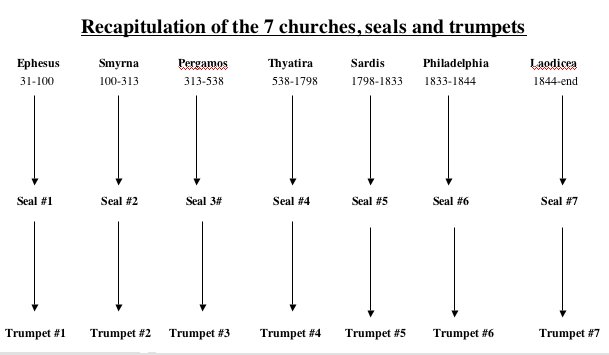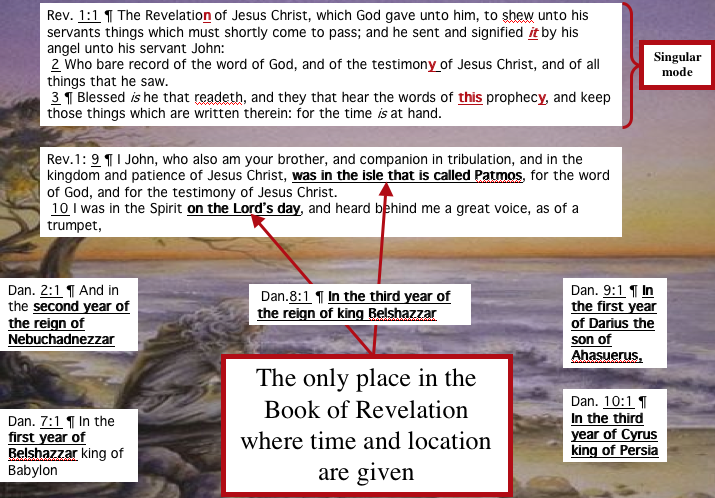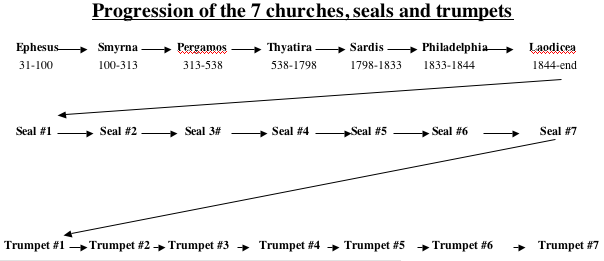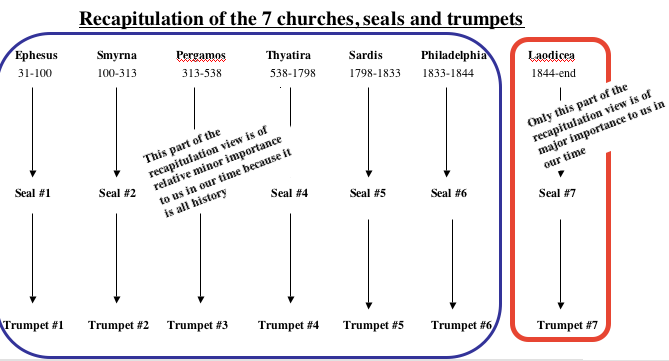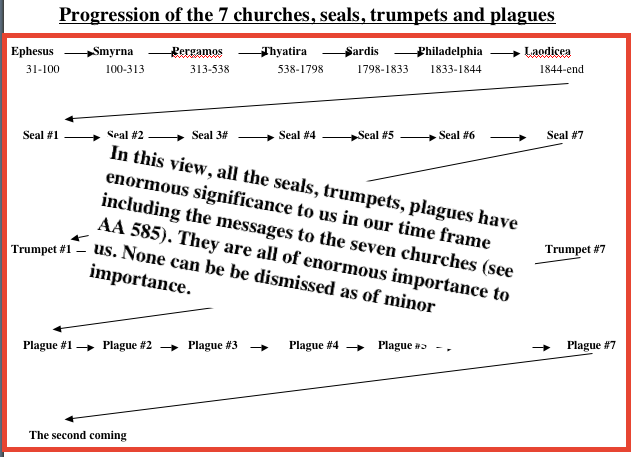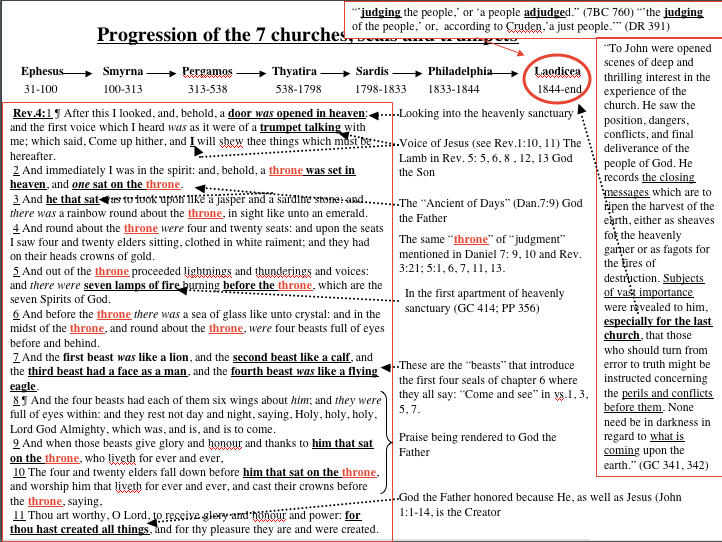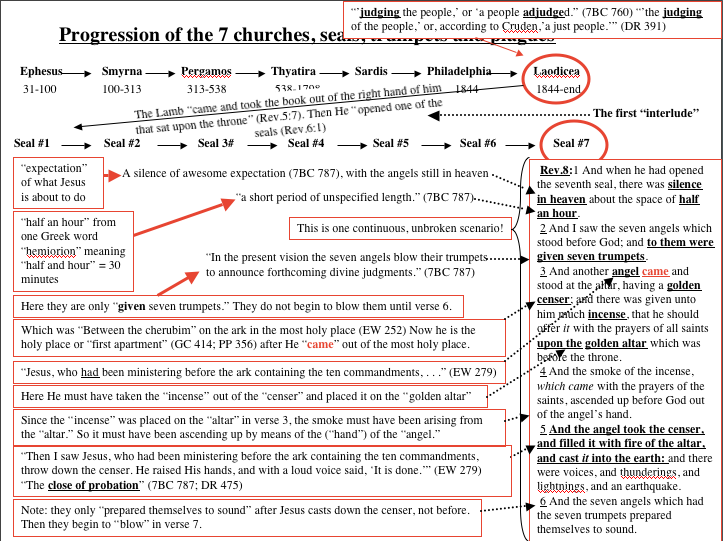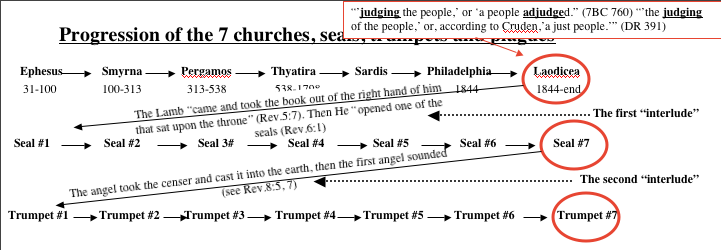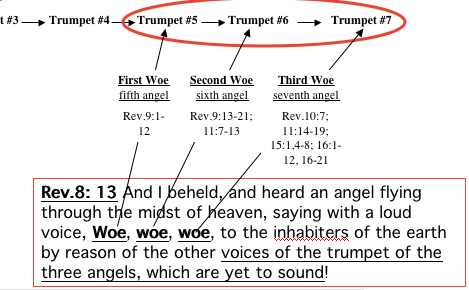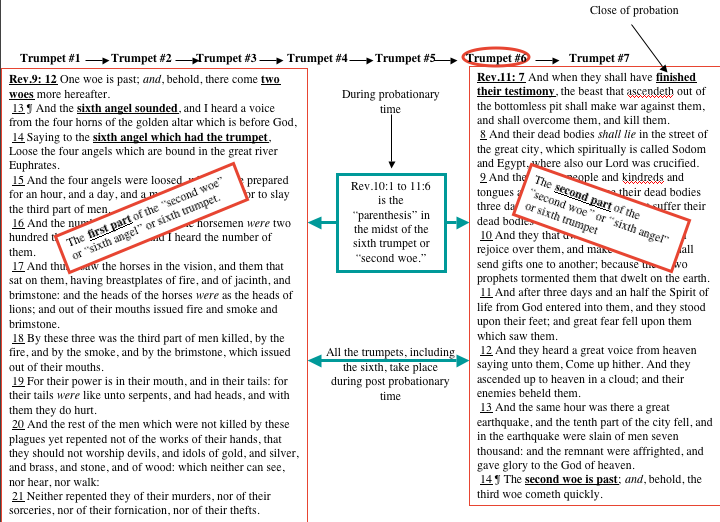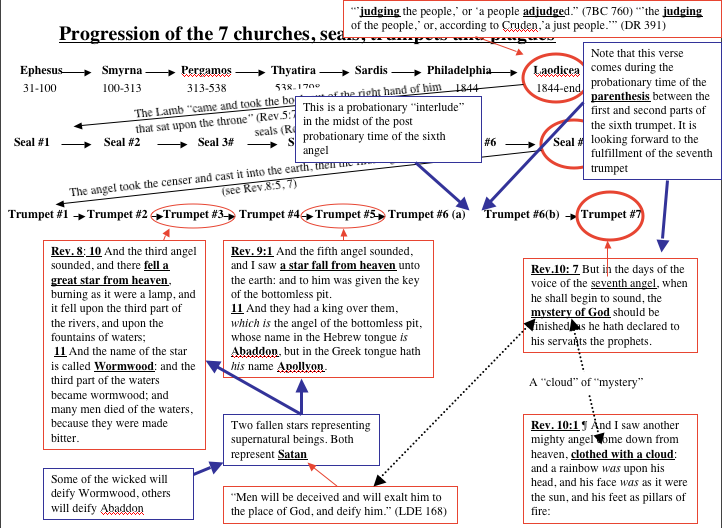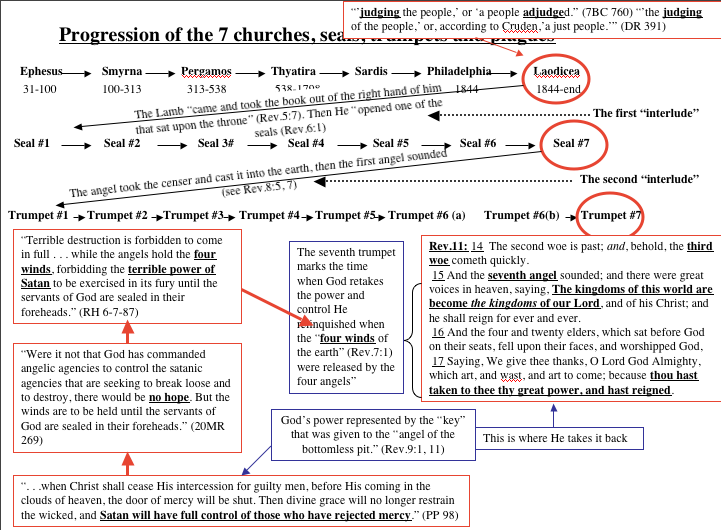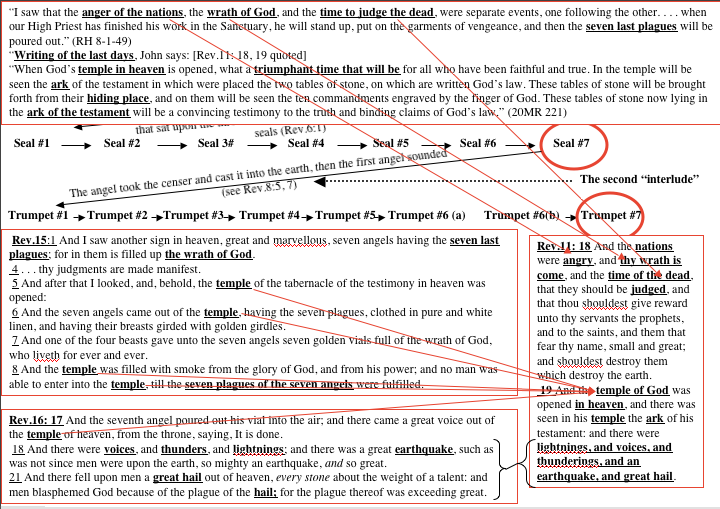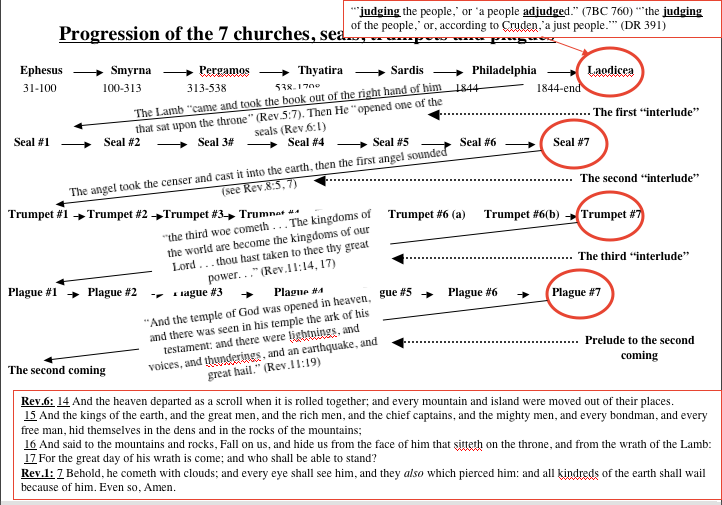A work entitled “Recapitulation in Revelation 4-11” by Ekkehardt Mueller of the Biblical Research Institute states that “one has basically two options. One can chose recapitulation or progression.” In the previous part I, I discussed the “recapitulation” formate of the seven churches, seals and trumpets of Revelation 2 to 16 as illustrated in this diagram (compare this diagram with the progression diagram on page 3):
As noted in the Commentary “The view favored by Seventh-day Adventists is that these trumpets retrace, to a large extent, the period of Christian history already covered by the seven churches (chs. 2; 3)and the seven seals (chs.6; 8:10), and that they emphasize outstanding political and military events during this period.” (7BC 788) In other words, Adventists favor the concept that the seven trumpets and seals recapitulate the history of the seven churches. This view has a long history, dating, at least to the time of Uriah Smith as we noted in our study of recapitulation.
It somewhat understandable that this view should be so greatly favored if for no other reason that the five main visions and prophecies of the book of Daniel were arranged in that very manner. For example, the symbols found in the seventh and eight chapters basically repeat the gold, silver, brass and iron of the great image of chapter 2.
Check out this diagram showing how we not only related the features of chapters 2, 7 and 8, but those of chapter 11:
Note, however, that each of Daniel’s visions follow the progression formate with the silver following the gold, the brass following the silver, and the iron following the brass in Daniel 2. Likewise, the bear following the lion, the leopard followed the bear and the fourth beast followed the leopard in chapter 7. The same applies to the ram and the he-goat in chapter 8. Then, of course, the same progression formate is seen in chapter 11.
Nevertheless, it need not be surprising that such men as Uriah Smith took up the recapitulation formate and applied it to the book of Revelation, probably because they considered it to be made up of a number of different visions rather than one.
But, that is a basic assumption that must be addressed. Consider this pictorial diagram where I attempt to illustrate my point that the book of Revelation is only one vision:
Note in Revelation 1:1-3 that the “Revelation” is singular. If it were more than one “Revelation” it should have been “the RevelationS.” Likewise “it” should be “them,” “testimony” should have been “testimonies,” and “prophecy” should have been “prophecies.”
Furthermore, it cannot be stressed enough that Revelation 1:9, 10 depict the only place in the book of Revelation where time (the seventh day Sabbath) and location (the “isle of Patmos”) are announced. In contrast, the time of each of Daniel’s visions were announced to to be “the second year of the reign of Nebuchanezzar,” the “first year of Belshazzar,” “the third year of the reign of king Belshazzar,” “the first year of Darius” and “the third year of Cyrus.” There, the location can be assumed to be the city of Babylon except in Daniel 8:2 were the prophet makes clear he was “at Shushan in the palace . . . in the province of Elam.”
Therefore, instead of adopting the recapitulation mode used in the book of Daniel where each successive vision recapitulated the former, the progression mode found in each of Daniel’s vision should have been applied to the book of Revelation because it is only ONE vision with many “things” (see verse 1) depicted in it: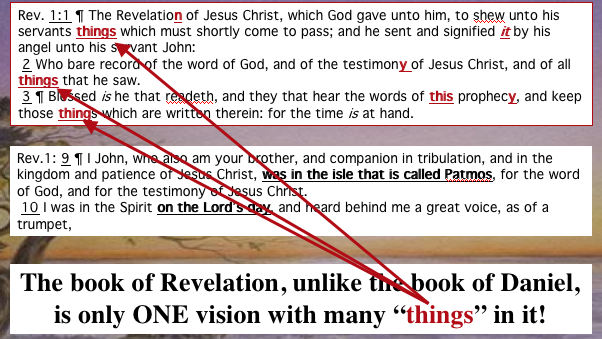
Uriah Smith “is best remembered for his book generally known by the short title Daniel and the Revelation. It received the warm endorsement of Ellen G. White and had an unrivaled influence on SDA prophetic teachings. Thoughts, Critical and Practical, on the Book of Revelation was published in 1867, and Thoughts, Critical and Practical, on the Book of Daniel, in 1873. These books, combined in one volume, were first sold by George King, thus marking the beginning of the sale of doctrinal subscription books in the colporteur work of the SDA Church. This work, now entitled The Prophecies of Daniel and the Revelation, was revised several times, during Smith’s lifetime and later, and it still has a wide circulation.” (Seventh-day Adventist Encyclopedia page 1356)
Some twenty years after 1873, when Daniel and the Revelation were published, Mrs. White wrote: “We are not to think, as did the Jews, that our own ideas and opinions are infallible; nor with the papists, that certain individuals are the sole guardians of truth and knowledge, that men have no right to search the Scriptures for themselves, but must accept the explanations given by the fathers of the church. We should not study the Bible for the purpose of sustaining our preconceived opinion, but with the single object of learning what God has said.
“Some have feared that if in even a single point they acknowledge themselves in error, other minds would be led to doubt the whole theory of truth. Therefore they have felt that investigation should not be permitted, that it would tend to dissension and disunion. But if such is to be the result of investigation, the sooner it comes the better. If there are those whose faith in God’s word will not stand the test of an investigation of the Scriptures, the sooner they are revealed the better; for then the way will be opened to show them their error. We cannot hold that a position once taken, and idea once advocated, is not, under any circumstances, to be relinquished. There is but One who is infallible–He who is the way, the truth, and the life.” (Gospel Workers, 1893 edition, pages 125-131; also Testimonies To Ministers and Gospel Workers page 105).
More specifically in 1902 she wrote: “Our lesson for the present time is, How may we most clearly comprehend and present the gospel that Christ came in person to present to John on the isle of Patmos–the gospel that is termed ‘the Revelation of Jesus Christ’? We are to present to our people a clear explanation of Revelation. We are to give them the Word of God just as it is, with as few of our own explanations as possible. No one mind can do this work alone. Although we have in trust the grandest and most important truth ever presented to the world, we are only babes, as far as understanding truth in all its bearings is concerned. Christ is the great Teacher, and that which He revealed to John, we are to tax our minds to understand and clearly to define. We are facing the most important issues that men have ever been called upon to meet. The theme of greatest importance is the third angel’s message, embracing the messages of the first and second angels. All should understand the truths contained in these messages and demonstrate them in daily life, for this is essential to salvation. We shall have to study earnestly, prayerfully, in order to understand these grand truths; and our power to learn and comprehend will be taxed to the utmost.” (12MR 212-213; CW 29)
Therefore, instead of jealously guarding and protecting the preconceived, recapitulationists view of the seven churches, seals and trumpets, a reconsideration of that concept is actually a divine imperative in spite of Ellen White’s warm endorsement of Uriah Smith’s valuable effort to explain the mysteries of the books of Daniel and Revelation. It was a good effort, worth reading even today, but it was not the “last word” even from Mrs. White’s point of view.
At this juncture, lets address ourselves to the other “option” brother Mueller alluded to which is “progression,” the alternative to “recapitulation.” He asserted that “progression, as opposed to recapitulation, discerns only one final climax in the Book of Revelation. Everything leads up to this culmination. For example, the seven trumpets do not, to a certain extent, cover the same ground which the seven seals have already encircled, but grow out of the seals and are their extension.” In other words, in the progression formate, each church, seal and trumpet are allowed to stand on their own and are not to be considered parallel to each other.
Consider this diagram which is simply a rearrangement of the arrows in the previous diagram:
But, it is not necessary to stop here because there is one more set of “sevens” that must be considered which is the “seven last plagues” depicted in Rev.15 and 16. In contrast to recapitulation where they have no place at all except at the three “ends,” the progression formate opens up a logical progression to the most notable feature of the book of Revelation, the second coming of our Lord and Savior in the clouds of heaven. Check out this completed diagram of the progression formate:
Another comparison bears comment. In the recapitulation view, only the last elements, namely, the seventh church, seventh seal and seventh trumpet bear major relevance to us in our time. Check out this diagram:
Little wonder that “preterists often defend recapitulation” as Ekkehardt Mueller observed in his work titled “Recapitulation in Revelation 4-11.”
The progression view offers a far greater potential:
This is why brother Mueller comments: “If one chooses progression one will end up with a different end time scenario from the one recapitulationists hold.” He leaves it up to the individual to decided whether that is a good or bad choice.
It is true that the seven churches depict the condition of the church throughout the Christian era, as stated in the Spirit of Prophecy. But, even though “The names of the seven churches are symbolic of the church in different periods of the Christian Era”, the statement continues that “The number 7 indicates completeness, and is symbolic of the fact that the messages extend to the end of time, while the symbols used reveal the condition of the church at different periods in the history of the word.” (AA 585) This means that we cannot safely dismiss even the past six end time messages!
It is of major importance to us that we at least understand (1) the “first love” of Rev.2:4; the “synagogue of Satan” (Rev.2:9); the doctrines of “Balaam” and the “Nicolaitans” (Rev.2:14, 15); The doctrine of “that woman Jezebel” (Rev.2:20); the “name that thou livest, and art dead” (Rev.3:2); the “synagogue of Satan” (Rev.3:9); and the “lukewarm” condition (Rev.3:16).
In that case, we need to seriously consider the messages to all previous six churches and add them to the problems good and bad to our church in Laodicea. Could that be the reason Jesus’ recommended “eyesalve” as one of the needed remedies for the ills of our church?
This statement is better understood in the progression formate: (After quoting Rev.1:1-3)”Our Instructor presented the solemn messages that have been given in their order in Revelation, and that are to occupy the first place in the minds of God’s people.” (SpM 321)
But, the point of this study is to examine the “progression” view. In that view, we focus on the last of the seven churches, the last of the seven seals, the last of the seven trumpets and finally, the last of the seven plagues to see if they actually are transitional points from the last church to the first seal, the last seal to the first trumpet, the last trumpet to the first plague, and finally, the last plague to the second coming. Check out this diagram that illustrates that point:
In this study, we will have to skip over most of the details of the book of Revelation and focus on what I call transition points; namely the last church, the last seal, the last trumpet and the last plague. That will help us substantiate the fact that the seven churches, seals, trumpets and plagues stand alone and follow each other sequentially rather than standing together in parallel.
If understood in that manner, it will be seen that the seven churches, seals, trumpets and plagues comprise a skeletal framework upon which all the other details in the Revelation can be assigned. The potential is that this view not only causes the Revelation to become far more understandable, it will become far more relevant to us who are living in the final moments of this world’s history.
To begin, check out the next diagram that focuses on what comes next after the last church has been presented in Revelation 3:14-22. Note, first of all, the significance of the meaning of Laodicea as suggested by the Commentary and Uriah Smith. That should immediately put us on notice that there is a strong association between this church and the Judgment:
In this scene John is looking through a “door” into heaven whereas in chapters 2 and 3 he was looking at the seven churches on earth. So, while chapters 2 and 3 concerned the problems, both good and bad, of the seven churches on earth with the last being among the worst, this chapter raises our eyes to the very place in heaven where Jesus was actually standing — in the heavenly sanctuary where He had just been delineating the characteristics (good and bad) of the seven churches in chapters 2 and 3.
Note the words “after this” in verse 1. The Commentary, which espouses the recapitulation view, suggest that “the words ‘after this’ do not imply any chronological relationship between the closing events of the preceding vision and the one about to be related.” (7BC 766) But, in consideration of the progression view that we are adopting in this study, the word “this” can easily be seen as indicative of the last church of Laodicea and that the things depicted in chapter 4 are indeed chronologically related to that church and should be interpreted in the context of the last church rather than the first church of Ephesus as held in the recapitulation view.
Some believe that John suddenly became aware of the Lamb’s presence only in chapter 5. (for example, see God Cares Vol.2 pages 170, 171) But, it is clear that the trumpet-like voice in the first verse of this chapter was the same “great voice, as of a trumpet, saying, I am Alpha and Omega, the first and the last” in Rev.1:10, 11. John knew it belonged to no other than the One who had been speaking to him throughout chapters 2 and 3 telling him all about the problems of the seven churches. Therefore, Jesus, called “the Lamb” in Rev.5:6, 8, 12 & 13, is inviting John to have a look into the heavenly sanctuary. Therefore, Jesus was acting, as it were, a tour guide showing John the “throne” He had just depicted in Rev.3:21 where He had been siting with His “Father in his throne.”
By this time, more than thirty years had elapsed since Jesus’ ascension (see Acts 1:10) and the heavenly inauguration ceremony. Following that, ten days later, the pouring out of the Holy Spirit fell upon His disciples including John himself. (see for example ST 12-1-98; RH 4-30-08)
Therefore, this scene does not depict Christ’s enthronement in heaven (that actually took place more than thirty years before John received this vision), but it does set the stage for an equally important occasion, the details of which are spelled out in chapter 5.
Note that the Commentary and Uriah Smith allude to the significance of the name Laodicea as “judging the people” or “the people adjudged.” While the preceding churches all came under the searching eye of the Savior, this one, Laodicea, being the last, is to be judged even more searchingly. It is in the context of this church that “to John were opened scenes of deep and thrilling interest . . . He saw the position, dangers, conflicts, and final deliverance of the people God. He records the closing messages which were to ripen the harvest of the earth, either as sheaves for the heavenly garner or as fagots for the fires of destruction. Subjects of vast importance were revealed to him, especially for the last church, that those who should turn from error to truth might be instructed concerning the perils and conflicts before them. None need be in darkness in regard to what is coming upon the earth.” (GC 341)
So, it is inescapable that we belong to the very “last church” and, as noted in the above quote, we have no excuse for not knowing “what is to come upon the earth” or what will take place in the future. That statement suggests that Jesus Himself in the last book of the Bible has laid it all out for us and that the progression formate, which places the whole book of Revelation as indicative of “the perils and conflicts BEFORE (not behind) US,” is what He actually had in mind.
At this point, begin to compare the scene here with that of Daniel 7:9 where Daniel “beheld till the thrones were cast down, and the Ancient of days [God the Father] did sit whose garment was white as snow, and the hair of his head like the pure wool: his throne was like the fiery flame, and his wheels as burning fire.” That is remarkably similar to Jesus’ appearance in Rev.1:13-15. But to John in this scene, the appearance of God the Father is likened to precious gem stones in verse 3.
Since “seven lamps of fire” are seen “burning before the throne” in verse 5, it is clear that this was the first apartment of the heavenly sanctuary. (see GC 414 and PP 356). Another point to consider is that of the “four beast” (“living creatures”) in verse 7, each announce the opening of the first four seals of chapter 6 saying “come and see.” This suggests that this scene into the heavenly sanctuary is closely connected to chapter 6 where the first six seals are opened. It also suggests that none of the seals were opened prior to the church of Laodicea.
Another important point to recognize, is that the praise service depicted in verses 8-10 is being rendered to God the Father with Jesus and John looking on. Therefore, this scene is not the enthronement of Jesus which took place more than thirty years before.
Finally, while Jesus is also depicted in John 1 as the creator, God the Father is also The Creator and Jesus wanted John and us to understand that.
But, the question remains, is chapter 4 to be considered in the context of all seven of the seven churches, or in context with only the last church, Laodicea? Before answering that question, lets look at Laodicea in context with Revelation 5:
This is the same setting depicted in chapter 4 except that the “book” held in the hand of God the Father, called “the Ancient of Days” in Daniel 7, is something new. Note also, that Jesus, who conducted the tour of the heavenly sanctuary in chapter 4, now depicts Himself as the “Lamb” who here comes and takes “the book out of the right hand of” God the Father in verse 7. This must be the same thing that happened in Daniel 7:13 when “one like the Son of man came to the Ancient of days.” Note that neither Daniel nor John say anything about a transition from one literal place to another when this divine approachment transpired. However, we know this must be the beginning of the Investigative Judgment beginning in 1844 because the identical scene is depicted in Daniel 7:9, 10, 13 “where our great Hight Priest enters the holy of holies . . . to engage in the last acts of His ministration in behalf of man, —to perform the work of investigative judgment, and to make an atonement for all who are shown to be entitled to its benefits.” (GC 479, 480)
Consider this diagram pointing out the numerous parallels between Revelation 5 and Daniel 7:9, 10, 13:
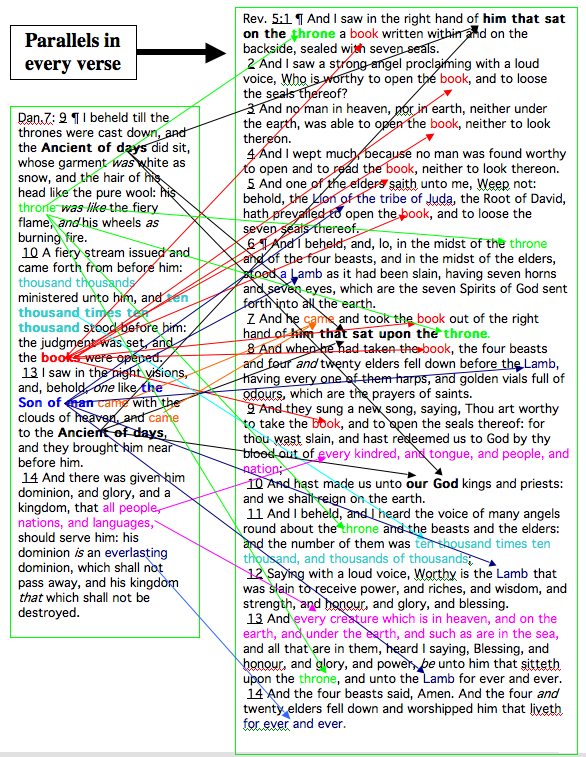 Although the many arrows might, at first, seem confusing, look carefully at their colors and it will be seen that there is close correspondence between Daniel 7:9, 10 and 13 with Revelation 5. If the scene in Daniel 7 is the Investigative Judgment (see GC 479, 480), Revelation 5 also depicts the Investigative Judgment scenario and complements the same scene in Daniel 7.
Although the many arrows might, at first, seem confusing, look carefully at their colors and it will be seen that there is close correspondence between Daniel 7:9, 10 and 13 with Revelation 5. If the scene in Daniel 7 is the Investigative Judgment (see GC 479, 480), Revelation 5 also depicts the Investigative Judgment scenario and complements the same scene in Daniel 7.
Clearly, this is what makes “the fifth chapter of Revelation” of such “great importance as noted in 9T 267. This judgment is of enormous importance “to those who shall act a part in the work of God for these last days” which is in the context of the last church. It follows, that those who do not realize this are “deceived” and we should pray that our eyes will be anointed with the “eyesalve” Jesus offers the Laodiceans in Rev. 3:18.
Note the “book” mentioned eight times in this chapter. Its importance is emphasized in these statements: “There in His open hand lay the book, the roll of the history of God’s providences, the prophetic history of nations and the church. Herein was contained the divine utterances, His authority, His commandments, His laws, the whole symbolic counsel of the Eternal, and the history of all ruling powers in the nations. In symbolic language was contained in that roll the influence of every nation, tongue, and people from the beginning of earth’s history to its close. . . . The destiny of every nation was contained in that book. . . . John continues: [verses 6, 7, quoted]. As the book was unrolled, all who looked upon it were filled with awe. There were no blanks in the book. There was space for no more writing. [Rev. 5:8-14; 6:8-11; 8:1-4, quoted.]” (12MR 296, 297)
In other words, the content of this book, as well as the “books” of Daniel 7:10, is absolutely comprehensive, inclusive of all that has ever happened to every person, nation and kingdom who has ever existed from the beginning to the end of time. Therefore this “book” must be identical to the “books” of Daniel 7:10. Clearly, it is a book of records that enables the onlookers, depicted as “ten thousand times ten thousand, and thousands of thousands of” “angels” (verse 11) in heaven to praise God for the justice and mercy of His Judgments. Bear in mind that it is opened to the angels in heaven. It will be opened later on to the view of God’s people during the “thousand years” mentioned in chapter 20 verse 4.
So, it is clear that “him that sat on the throne” in verses 1 and 7 as well as ch.4:2, 3, 9 is the same Person called “the Ancient of days” in Daniel 7:9, 13 and 22.
Likewise, the “Lamb” who “came and took the book out of the right hand of him that sat upon the throne” in Revelation 5:6, 7, is the same Person depicted as “one like unto the son of man” who “came to the Ancient of days” in Daniel 7:13.
Those similarities as well as other parallel details between Revelation 5 and Daniel 7 is clear evidence that Revelation 5 depicts the commencement of the Investigative Judgment that began at the end of the 2300 days of Daniel 8:14 October 22, 1844. For more information on that point, check out the above diagram and the discussion of Revelation 5 in the following exposition. There you can find more discussion and illustrations of the parallels existing between Revelation 5 and Daniel 7:9, 10, 13.
So, it is in the context of the Investigative Judgment that the seven seals begin to be opened. There is nothing in either chapters 4 or 5 to suggest we must look back to the first church of Ephesus to find parallels to the seals as the recapitulation view recommends.
Therefore, it should be clear that the scenes depicted in chapters 4 and 5 are contextual with the church in Laodicea beginning in 1844 and extending to the end. It was only during that time that our Lord made His way from the holy to the most holy place in the heavenly sanctuary to begin the Investigative Judgment.
That scene is depicted here in one of Ellen White’s marvelous visions: “I saw a throne, and on it sat the Father and the Son. I gazed on Jesus’ countenance and admired His lovely person. The Father’s person I could not behold, for a cloud of glorious light covered Him. I asked Jesus if His Father had a form like Himself. He said He had, but I could not behold it, for said He, ‘If you should once behold the glory of His person, you would cease to exist.’ Before the throne I saw the Advent people–the church and the world. I saw two companies, one bowed down before the throne, deeply interested, while the other stood uninterested and careless. Those who were bowed before the throne would offer up their prayers and look to Jesus; then He would look to His Father, and appear to be pleading with Him. A light would come from the Father to the Son and from the Son to the praying company. Then I saw an exceeding bright light come from the Father to the Son, and from the Son it waved over the people before the throne. But few would receive this great light. Many came out from under it and immediately resisted it; others were careless and did not cherish the light, and it moved off from them. Some cherished it, and went and bowed down with the little praying company. This company all received the light and rejoiced in it, and their countenances shone with its glory.
“I saw the Father rise from the throne, and in a flaming chariot go into the holy of holies within the veil, and sit down. Then Jesus rose up from the throne, and the most of those who were bowed down arose with Him. I did not see one ray of light pass from Jesus to the careless multitude after He arose, and they were left in perfect darkness. Those who arose when Jesus did, kept their eyes fixed on Him as He left the throne and led them out a little way. Then He raised His right arm, and we heard His lovely voice saying, ‘Wait here; I am going to My Father to receive the kingdom; keep your garments spotless, and in a little while I will return from the wedding and receive you to Myself.’ Then a cloudy chariot, with wheels like flaming fire, surrounded by angels, came to where Jesus was. He stepped into the chariot and was borne to the holiest, where the Father sat. There I beheld Jesus, a great High Priest, standing before the Father. On the hem of His garment was a bell and a pomegranate, a bell and a pomegranate. Those who rose up with Jesus would send up their faith to Him in the holiest, and pray, ‘My Father, give us Thy Spirit.’ Then Jesus would breathe upon them the Holy Ghost. In that breath was light, power, and much love, joy, and peace.
“I turned to look at the company who were still bowed before the throne; they did not know that Jesus had left it. Satan appeared to be by the throne, trying to carry on the work of God. I saw them look up to the throne, and pray, ‘Father, give us Thy Spirit.’ Satan would then breathe upon them an unholy influence; in it there was light and much power, but no sweet love, joy, and peace. Satan’s object was to keep them deceived and to draw back and deceive God’s children.” (EW 54-56) Clearly, this heavenly scenario applies to both Daniel 7 and Revelation 5.
So, once again we see that the last church is the transition point from the seven churches to the seven seals with chapters 4 and 5 becoming the first “interlude” between the seven churches and the seven seals.
In this next diagram we skip over the details of the first six seals to focus on the seventh to see if it, like the seventh church, is a transition point from the seals to the trumpets.
First, review Rev.8:1-6 on the right, then follow the arrows to see how the trumpets, in effect, grow out of and are extensions to the opening of the seventh seal:
Instead of being broken up into unrelated segments with the second coming in verse 1, followed by the blowing of the trumpets in verse 2 followed by the continuous ministry of Christ in verses 3 and 4, then the close of probation in verse 5 as presented in the recapitulation view, verses 1 to 6 can easily be seen as one continuous, unbroken scenario in the progression view.
In that manner, the “silence in heaven” which lasts approximately thirty minutes instead of two weeks, denotes the situation with the heavenly onlookers who are waiting with baited breath as the seven angels are being given their trumpets, then Jesus exits the most holy place of the heavenly sanctuary with the golden censer in His hand from which incense had been ascending before God the Father during His most holy place administration.
While the Commentary suggests that the seven angels “blow their trumpets” in verse 2, it is important to recognize that they do not blow them until verse 7 after Jesus casts the censer down in verse 5.
Consider also that Jesus takes the incense out of the censer and places it on the golden altar, then fills the censer entirely with fire of the altar without incense and casts it down to the earth. Since the incense represents the “blood of atonement,” His atoning ministry has come to an end. Probation is closed at this point. Then, the waiting, trumpet bearing angels began to blow their trumpets in verse 7 which shatters the “silence in heaven” depicted in verse 1.
Therefore, in contrast to the recapitulation view, this all happens in logical sequence, and the second coming, which is supposed to take place in verse 1, has not yet occurred. Several more events are yet to take place. Consequently, Rev.8:1-6 can be seen as the second “interlude” between the seventh seal and the first trumpet.
Since the trumpet scenario begins when the censer is cast down in the context of the seventh seal, that last seal is the second point of transition, and we are ready to move on to the seven trumpets. Again, as we did with the last church, and the last seal, we will now focus on the last trumpet which, although more complex than the first transition, is not nearly as confusing as it is in the recapitulation view:
So, lets focus on trumpet #7 to see if it too is the transition from the seals to the trumpets. But, before beginning our study of the last trumpet, we must first understand the three woes first mentioned in Revelation 8:13. Check out this diagram:
According to Revelation 8:13 which follows the sounding of the fourth trumpet in verse 12, the last three trumpets are called “WOE’s.” Notice that each “woe” is identified by three names. The “first woe” is synonymous with the “fifth angel” and the fifth trumpet. The “second woe” is synonymous with the sixth angel and the sixth trumpet. Likewise, the “third woe” is synonymous with the seventh angel and the seventh trumpet. Uriah Smith (DR 491) basically points out the same thing. That might seem elementary at this point, but it is essential to understand that because they are so easily confused as we look farther into the seventh trumpet “third woe” scenario.
Note that the “seventh angel” is depicted three times in the book of Revelation, but only the “seventh angel” in Rev.10:7 and 11:15 is the “third woe.” The “seventh angel” of Rev.16:17 is a “vial” bearing angel and is not the “third woe” or the seventh trumpet bearing angel.
When “the seventh angel . . . shall begin to sound . . .” his trumpet in Rev.10:7, “the mystery of God should be finished.” In Rev. 11:15 “the seventh angel [also] sounded” his trumpet sometime after the two witnesses “shall have finished their testimony” in Rev.11:7. But in Rev.16:17 “the seventh angel poured out his vial . . .” which is the last of the seven last plague scenario.
The same thing pertains to the “sixth angel” which is mentioned three times in Rev.9:13, 14 and 16:12. However, only the “sixth angel of Rev.9:13, 14 is the “second woe” because they “sound” the “trumpet, while the sixth angel of Rev.16:12 has a “vial,” not a trumpet.
In Revelation 11:14, we note that the “third woe” begins when “the second woe is past.” Since the “second woe” mentioned only in Rev.11:14, it becomes necessary to refer to the above diagram showing that the “second woe” is also the “sixth angel.” Therefore, the beginning of the second “woe” is found in Revelation 9:13, 14 and ends in Revelation 11:13. But, that does not mean all of chapter 10 and most of chapter 11 depict the second woe or sixth trumpet!
Check out this diagram showing that their is a “parenthesis” in the midst of the “sixth angel,” sixth trumpet or “second woe”:
Remember, the “sixth angel” of Rev.9:13,14 is also “the second woe” of Rev.11:14 as can be recognized in the previous diagram.
Note that there are two parts to the “second woe” with the first part beginning in Revelation 9:12, 13 and ending in verse 21. The second part begins in Revelation 11:7 because that is where the “testimony” of the “two witnesses” is “finished” or that probation had closed, the same thing that happened when Jesus, in Rev.8:5, “took the censer, and filled it with fire of the altar, and cast it into the earth” which was the sign the seven trumpet bearing angels were waiting for to begin sounding their trumpets.
The intervening portion which separates the first and second parts of the sixth trumpet is found in Rev.10:1 to 11:6 which depict a probationary scenario. During that time the “little book” of Daniel was intensely studied by such men as William Miller who concluded that Jesus would come in 1844 at the end of the 2,300 days of Daniel 8:14. Their disappointment is represented by the bitterness that John experienced after he ate the “little book.” Unknown to God’s people at that time, the judgment of the dead had just begun in heaven. Following that bitter experience, God’s people were expected to “prophesy again before many peoples, and nations, and tongues, and kings.
The probationary scenario continues in Rev.11:1-6 with the first two verses depicting a judgment scene where the living worshipers at God’s temple are measured. That parallels the time of adversity experienced by the church during the Dark Ages of history when “the holy city” was “tread under foot forty and two months.” But, the same time period is depicted again in verse 3 suggesting that the adversity of the historic dark age is to be repeated (in literal time) in a future dark age when the cry of “the souls” “under the altar” asking “how long, O Lord, holy and true, dost thou not judge and avenge our blood on the that dwell [or live] on the earth?” (Rev.6:10)
Then in Rev.11:3-6, the “two witnesses” are given enormous “power” to “prophesy” and give the “loud cry” message of Rev.18:1-5 even though “clothed in sackcloth.” This is why Mrs. White wrote when commenting on “the eleventh chapter of Revelation. Read every verse, and learn the things that are yet to take place in the cities.” Then she adds: “Read also the scenes portrayed in the eighteenth chapter of the same book.” (21MR 91)
Then, when their “testimony is finished in Rev.11:7 probation has closed and the second part of the post probationary sixth trumpet scenario commences in verses 8-13.
So, five trumpets and half of the sixth will have sounded by Rev.9:21. Following the parenthesis of Revelation 10:1 to 11:7, the second half of the sixth trumpet or second woe begins in Rev.11:8 and ends in Rev.11:13. That is why Rev.11:14 says that “the second woe is past.” Then the “third woe” continues on to Rev.11:19 which is also the “seventh angel” which “cometh quickly” or “without delay” (according to the Greek word ‘tachu’) after the “second woe” or “sixth angel.”
Although this seems confusing and we wonder why God inspired John to write this part of his vision in this manner, we should recognize that Rev.10:1 to 11:6 is the parenthetical portion in the midst of the sixth trumpet that reverts back into probationary time and becomes what we could call an “interlude” or “parenthesis” between the first and second parts of the sixth trumpet instead of “between the sixth and seventh trumpets” as the Commentary, speaking from the recapitulation view, suggests (see 7BC 804).
No wonder Ekkehardt Mueler says that “the question of progression or recapitulation . . . is a decisive question for the person maintaining the historical interpretation of the Apocalypse. If one chooses progression one will end up with a different end time scenario from the one recapitulationists hold.” (See Ekkehardt Muller, Microstructural Analysis of Revelation 4-11, Andrews University Seminary Doctoral Dissertation Series, Vol. 21, 12.)
But, it is not a matter of “maintaining” a preferred point of view. What matters is which view harmonize with scripture rather than forcing scripture to harmonize with one’s point of view.
Therefore, we are obliged to conclude that the “third woe” did not begin in 1844. In fact all the trumpets are still future as substantiated by the “trumpet after trumpet, vial after vial” comment found in 1888 Materials page 762; 14MR 287 and 7BC 982 where it is affirmed that they are “solemn events before us” that are “yet to transpire.”
This puts us in position to understand the details of the seventh trumpet, “seventh angel” or the “third woe.”
The first mention of the “seventh angel” (or “third woe”) in is Rev.10:7. Check out this diagram. Start at the lower right where Rev.10:7 is quoted then follow the arrows. The blue arrows are my comments and the red are references from the Bible and the Spirit of prophecy:
At first glance, this might be confusing with many arrows pointing this way and that. But, keep looking and try to follow where the arrows are pointing. Begin with the box containing Rev.10:7 where the sounding of the seventh trumpet will finish the “mystery of God.” Then look down to the box containing Rev.10:1 where that “mystery” is represented by the “cloud” that cloths the “mighty angel” who is Jesus Christ (7BC 971). This suggests that, during the time of the trumpets, the literal identity of the true God will be a great question in the minds of the worldly inhabitants during the post probationary time of the trumpets.
In order to understand why that is such a “mystery,” we must refer back to the third and fifth trumpet scenarios where two fallen stars are depicted. While the recapitulationists (except for Mervyn Maxwell) hold that they represent Attila and Mohammed who are only human, it is clear that both represent Satan (see God Cares Vol.2, pages 240, 250) who will be deified as noted in LDE 168.
As the blue box indicates, some worship “Wormwood” as God while others follow “Abaddon” suggesting there will be a great polarization in the world during that time with some holding to Abaddon as God and others holding to Wormwood.
But, not all will be deceived. Note in Rev.10:1 that the mighty angel’s face is “as it were the sun” suggesting that the saints will understand exactly who God really is and will repudiate both Wormwood and Abaddon and hold to the “mighty angel.”
Then look at the two blue boxes above with the arrows pointing at the space between trumpet #6 a and #6b. They are trying to show that that “mystery” will have begun during the probationary interlude of time when the loud cry of will be given by the two witnesses (Rev. 11:3 to 6) warning the world that they are soon to be deceived by the greatest satanic hoax that has ever been perpetrated upon the world.
The Commentary suggests that “the mystery of God is ‘the mystery of the kingdom of God’ (Col.2:2) and ‘the mystery of Christ’ (Col.4:3).” (7BC 798) Uriah Smith believed it to refer to the time “when the great work of mercy for fallen man is completed . . . proclaiming in tones like thunder the solemn sentence, ‘It is done!’ Revelation 16:17.” (DR 525) So, both are, in essence, correct even though they hold to the recapitulationist view and would not be expected to refer to the third and fifth trumpet scenarios to bolster their argument.
Now, having examined the first appearance of the “seventh angel” in Rev.10:7, lets move to Rev.11:14 and 15 where the “third woe,” also called “the seventh angel” is again depicted. Consider this diagram which begin on the lower right under “Trumpet #7” (Remember that the “third woe” is also the “seventh angel”):
Even though this diagram looks “busy” and complicated, it really is not.
Start with the red box enclosing Rev.11:14 to 17 where the “third woe” and “seventh angel” are underlined in bold. Study the text which tells us that when the seventh trumpet is sounded God, in essence, takes back his “great power.” That suggests that He had previously relinquished it!
In order to understand how that could have happened, we must refer back to Rev. 7:1 where four angels are seen holding back the “four winds of the earth.” Now, note the three red boxes containing statements from the Spirit of Prophecy that tell us what the “four winds” represent, namely “the terrible power of Satan.” When the four good angels release the “four winds,” it means that Satan will then “have full control” of the wicked, which is exactly what occurs when Jesus throws down the censer followed by the sounding of the trumpets in Rev.8:5-7.
Consequently, Satan will be in the control of the wicked throughout the time of the first six trumpets. But, when the seventh angel sounds his trumpet, “The kingdoms of this world [will] become the kingdoms of our Lord” because He will have “taken to [Himself His] great power . . .” (Rev.11:17). That brings us to verses 18 and 19.
The next diagram depicts what happens in verses 18 and 19 and the parallels they are indicative of (its getting busier, but hang in there, you can get it!):
This diagram is intended to show the relationship of Rev.11:18 and 19 to the seven last plague scenario of Rev.15 and 16 with confirmation from the Spirit of Prophecy in RH 8-1-49 and 20MR 221.
Start reading the red box to the right which contains Rev.11:18 and 19 then read the quotes from RH 8-1-49 and 20MR 221 which quote those two verses in the context of the seven last plagues and the implied context of the second coming. Note that the angry nations, time of God’s wrath and the time to judge the wicked are all in the context of trumpet #7 or the “third woe.”
Then note the parallels pointed out by the red arrows between the “temple of God” in Rev.11:19 and Rev.15:5-8 and 16:17.
Probably the most convincing parallel is pointed out at the very bottom of the diagram where all five of the final events of the seven last plagues in Rev.11:19 match up with the very same thing in Rev.16:18 & 21.
It seem unquestionable, therefore, that the seven last plagues grow out of or are the extension of Trumpet #7 or the “third woe” or “the seventh angel” and that “when he shall begin to sound, the mystery of God should be finished” (Rev.10:7) by the sounding of that trumpet.
While it will take more than one plague to eradicate that “mystery,” clearly, when “the sixth angel poured out his vial upon the great river Euphrates; and the water thereof was dried up, that the way of the kings of the east might be prepared” followed by the “great hail” of the last plague (Rev.16:12, 21), even that might not be quite enough.
But, one more event that is sure to clear up the mystery will follow. Check out this final diagram:
This diagram displays all three “interludes” followed by the the seventh plague scenario with is really the “prelude” to the second coming. Then, because the second coming is only depicted in the beginning of John’s vision in Rev.6:14-17 and 1:7, we must conclude it to be the great and final consummation in the progression formate.
Note also that the “third woe” is all seven of the “seven last plagues” with the seventh being the “prelude” to the second coming.
So, the progression view, as opposed to recapitulation, leads to only one final climax in the book of Revelation which, from my perspective, is the second coming. It transpires very soon after the seventh plague is poured out which makes Plague #7 the last of the four transition points. Clearly, no other event could finish the mystery of God like the second coming. Note that even the wicked have no doubt whatsoever about who God is. They are even able to identify Him as “the Lamb!” All their thoughts about Wormwood or Abaddon being God, has evaporated!
This completes our study of the progression formate with its four main points of transition. Obviously, there is much more to learn since this study did not touch on the first six seals, trumpets number 1, 2 and 4, and the first six plagues. However, in the following studies of the entire books of Daniel and Revelation, I have unintentionally followed the progressive view taking for granted that each chapter must be interpreted in the context of the previous chapters.
Note again that the “seven seals” are the extension of the last church. Then the seven trumpets become the extension of the seventh seal. Afterwards, the seven last plagues are the extension of the seventh trumpet and finally the second coming, the most climactic event in the history of the universe as well as the whole world, is the extension of the seventh plague.
Some might wonder if this view can be proved by the Bible alone without the Spirit of Prophecy. My answer is “Yes, absolutely!” I have used the Spirit of prophecy quotes in order to convince myself as well as any Seventh-day Adventist who might care to listen. But, to non SDA’s, this view is logical, connected and relatively easy to understand from the Bible alone. And, it is my feeling that if we were to advance this “new principle” and “crowd in [these] clear -cut” truths “many more would believe the message.” (TM 118 paraphrased)
God bless you and may this continuing study foster the “blessing” promised by our Dear Saviour who said: “Blessed is he that readeth, and they that hear the words of this prophecy, and keep those things which are written therein: for the time is at hand.” (Rev.1:3)
